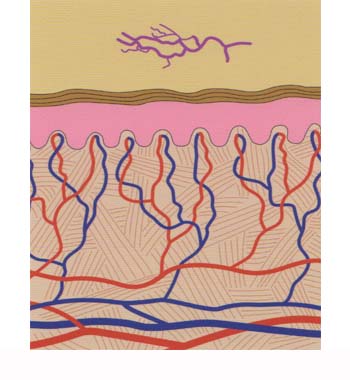Sclerotherapy treats dilated veins and broken vessels, in particular those on the legs.
A substance called a sclerosant is injected into the dilated vessel leading to damage of its internal lining. A resulting blood clot blocks the blood flow through the vessel. The damaged vessel is gradually replaced by scar tissue, the type of tissue that accumulates during any wound healing process. This scar tissue sometimes feels hard under the skin. Hence the name sclerotherapy (”skleros” is an old Greek word for “hard”). Eventually it is eliminated by the body so that the vessel disappears without leaving a trace. In case of telangiectasia, a blood clot may not be formed. Instead, the blood vessel will collapse with its walls stuck together, precipitating scar tissue formation. Since dilated veins are not functioning, they can be removed without affecting the circulation of the legs.
Several substances serve as injections for sclerotherapy, of which “polidocanol” is most widely used at present. With its anesthetic effect, polidocanol is well-tolerated. Injection with a very fine needle minimizes the pain to a degree that you only feel a pin prick when the needle penetrates the skin. One session of sclerotherapy usually takes 30 minutes to one hour.

sclerotherapy
After each injection, a cotton roll will be attached to the skin with tape to exert pressure on the treated vessel. After completing all injections, the whole treated area is covered with an elastic bandage to give further compression. There is no need for follow-ups or special aftercare. The compression bandage has to be left in place for up to 72 hours. The patient can remove this bandage at home. Removal of the bandage often reveals red and blue spots caused by inflammation and bruising. They usually disappear within two weeks. Red blotches turn easily into brown discolorations, so the skin should not be exposed to the sun without applying a sun screen until redness goes down. Part of the vessels may already have disappeared when the bandages are removed. Other vessels will gradually fade away over a period of several days to weeks. Several sessions are often necessary before the completion of treatment, because some vessels only disappear after repeated injections and patients who are prone to it are likely to keep getting new ones.
Serious side effects are extremely rare. Hives due to an allergy to the injected substance may occur. Also temporary discolorations and aggravation of telangiectasia are possible.